
Sony Answers The Three Big Questions about DAT.
Why
Why do I need Digital Audio Tape? Why are people making such a fuss over this new format? Isn't Compact Disc the answer to all my audio needs? Isn't the analog audio cassette destined to continue forever? The questions may sound simplistic, but they're well worth asking. Because any new format merits special attention. And because the answers shed light not merely on DAT, but on Compact Disc and the future of audio at large.
THE DIGITIZATION OF AUDIO.
Music lovers can be forgiven if they think of Compact Disc and digital audio as one and the same thing. So powerful and so successful has the Compact Disc been, that many consider the digital revolution to be an accomplished fact.
But in fact, CD is simply the first successful component of the digital age. Which means it was the first to introduce millions of Americans to the overwhelming benefits of digital audio. These include frequency response that's uniformly flat. A hundredfold decrease in distortion. Wow and flutter so low, they can't even be measured. And most important of all, dynamic range approaching that of a live concert.
The CD introduced digital disc playback to the home. In effect, making your CD player the digital turntable. In like fashion, many more digital components are on their way. We've already seen the dawn of Digital Signal Processing (DSP) preamplifiers and soon we'll see Digital Audio Broadcast (DAB) tuners. And it's no coincidence that more and more components are offering direct digital-to-digital interlace. Digital Audio Tape (DAT) fits perfectly into this larger pattern, bringing all the sonic benefits of digital audio to tape recording and playback.
And just as analog cassettes coexisted with LP's, DAT will coexist with CD "sister" formats of the digital age.
THE DAWN OF DIGITAL RECORDING.
Far from being a recent development, digital recording actually preceded the Compact Disc. After all, professional digital recorders were needed to create the master tape for every Compact Disc. In fact, the modern age of digital recording dates back to the introduction of Pulse Code Modulation (PCM) processors in the 1970's.
During those years, Sony realized that the extraordinary recording bandwidth of professional VCR's could be used to record stereo sound encoded as PCM digital signals.
Sony reasoned that encoding the sound in this way would result in tremendous sonic benefits the same benefits familiar to any CD enthusiast today. The first result of Sony's thinking was the world's first home digital component, the Sony PCM-1 in 1977. When connected to an ordinary home VCR, the PCM-1 made possible audio recording of unprecedented quality.
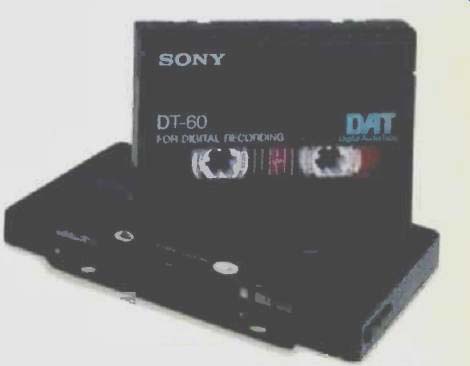
------Holding up to 2 hours of CD-quality sound, the DAT cassette is a mere
47% the size of a standard analog cassette.
GATHERING STEAM.
The PCM-1 was quickly followed by the world's first processor for CD mastering, the Sony PCM-1600, in 1980. (To this day, more CD's have been mastered on Sony 1600 Series processors than on all other brands combined.) Next came the world's first portable digital system, the legendary PCM-F1 in 1981. Its digital to-analog conversion circuitry was to influence the design of the first generation of CD players, introduced the following year. The trail of development soon led to the professional DASH-format open-reel decks that reign at today's top recording studios. Sony's 2-track, 24-track and 48-track recorders constitute the world's best-selling professional digital series.

-----------THIS COMPARISON IS NO COMPARISON: ANALOG CASSETTE VERSUS DAT.
THE COMING OF DAT.
With professional digital recording an accomplished fact by the early 1980's, Sony embarked on developing an easy-to-use consumer digital recording format. Unlike the PCM processors, which recorded digital audio onto videocassettes, this would be a dedicated audio format.
It would have to be small, to accommodate portable and autosound applications. It would have to support a variety of time, track number and search functions. And it would have to equal the audio performance of the newly-introduced Compact Disc.
Sony met these goals in 1982 with a proposed format using the rotating head-drum technology of VCR's. The prototype was called Rotary-Head Digital Audio Tape, or R-DAT for short.

----------- Sony's 48-track studio digital recorder, the PCM-3348.
But Sony did not take R-DAT directly to market. From our experience with Compact Disc, we understood that universal standardization is vital to a format's success. Sony knew that R-DAT hardware and software had to be interchangeable from manufacturer to manufacturer and country to country.
So Sony met with 83 other hardware, music and blank tape companies in the international Digital Audio Tape Conference. The conferees evaluated R-DAT versus competing tape technologies. They tested.
They probed. And they gave the go-ahead for full-scale development of the R-DAT format. Their efforts resulted in the DAT format we know today.
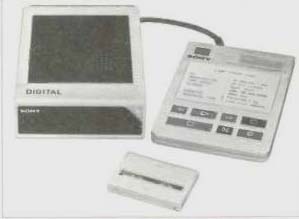
------------- Before anyone could agree on a worldwide standard for rotary-head
DAT, someone had to build the first prototype. That someone was Sony.
THE CURTAIN GOES UP ON A NEW ERA IN DIGITAL.
By April of 1987, Sony was marketing the new DAT recorders to consumers overseas.
Soon Sony professional DAT machines were being sold to recording studios worldwide.
Next Sony DAT duplication systems were introduced to help record companies establish the library of prerecorded DAT software. Now DAT is ready for the most important evaluation of all. Yours.
-----------
HOW
How does DAT work? How on earth does it capture 2 hours of CD-quality music on that miniature cassette? How did they get DAT to work in a car or portable player? And how did they overcome the challenge of tape wear and tear? The answer is surprisingly simple. DAT takes two familiar technologies and combines them in an unfamiliar way: the digital audio technology of the Compact Disc and the helical-scan recording technology of the VCR. Here's how.
THE KEYS TO DIGITAL SOUND.
Behind every digital audio format there stand two key parameters that before anything else takes place largely determine sound quality.
They are the quantization scheme and the sampling rate. Thus, the CD gets its spectacular dynamic range directly from 16-bit linear quantization. And the full, 20,000 Hz frequency response of CD is the direct result of the 44.1 kHz sampling rate.
The news is that the DAT format retains exactly the same 16-bit linear quantization and exactly the same 44.1 kHz sampling rate as CD. So you can expect the same spectacular sound from a DAT recorder as you're now getting from your CD player.
In addition, the 44.1 kHz rate enables record companies to release DAT titles from the same masters they use for CD. The DAT format also offers a 48 kHz sampling rate for recording from live and analog sources. And the option of the 32 kHz sampling rate facilitates a Long-Play Mode giving you up to four hours of FM-quality music on a single DT-120 cassette! The 44.1 kHz sampling rate does more than endow DAT with CD-quality sound. Along with direct digital inputs, it enables DAT to perform the amazing process of digital-to digital recording.*
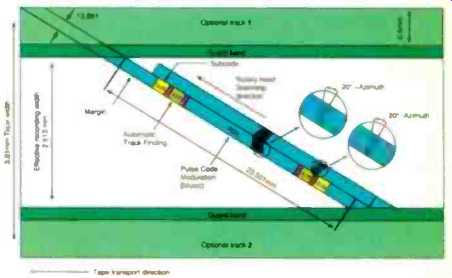
--------- As does a VCR, DAT records the signal onto the tape in a
series of diagonal tracks. Different azimuth alignment for A and B heads minimize
crosstalk. As in 8mm video, Automatic Track Finding (ATF) eliminates the complexity
of a separate control track.
THE CHALLENGE OF GETTING THE MUSIC ON TAPE.
While the digital specs of DAT undoubtedly assure high quality, they also require a recording bandwidth that's immense. A little arithmetic shows that while good analog decks have a bandwidth of 22,000 Hz, DAT requires much, much more. With a 48 kHz sampling rate, with each sample requiring 16 bits, and with two channels of sound to record simultaneously, the data rate is 48,000 x 16 x 2, or 1,536,000 bits per second. Which means a DAT recorder must have a bandwidth of at least 1,536,000 Hz!
VCR TECHNOLOGY TO THE RESCUE.
How does DAT derive its vastly increased bandwidth? From he helical scanning, rotary head technology of VCR's. All conventional audio recorders use stationary heads that record linear tracks as the transport drives the tape past the heads.
In analog cassettes, the tape moves past at a stately 1-7/8 inches per second (ips). Open reel analog decks achieve higher quality by moving faster anywhere from 7-1/2 ips up to 30 ips for professional recorders.
In contrast, DAT uses a rapidly spinning rotary head drum that records thousands of diagonal tracks. Typically spinning at 2,000 rpm, the drum lays down tracks with an effective tape-to head speed of over 120 ips more than four times faster than the finest professional analog decks. This high "writing" speed is the foundation of the DAT format. It makes possible DAT's unique combination of recording capability, spectacular sound, and amazing compactness. It also gives the head drum a flywheel effect that makes DAT particularly immune to the shock and vibration that can interfere with car stereo and portable audio systems.
DAT's diagonal tracks are themselves a study in microscopic precision. Each track is less than one tenth the thickness of a single human hair. The tracks fill the tape with information of such high density that each square inch holds 114 million bits of data. That's the equivalent of 7,100 typewritten pages in every square inch of tape!
ERADICATING ERRORS.
Considering recorded tracks of such amazing density, you might think that tape dropouts and tape wear would be formidable concerns. Thanks in part to Sony technology, the DAT format automatically overcomes the problem of tape irregularities. DAT records a vast quantity of redundant information that can be called upon at any time to identify and fill even large gaps in the music. All told, DAT incorporates twice the error-correction capability of CD. And as with CD, error correction doesn't just approximate the original data. It usually reconstructs that data completely.
EASY ACCESS.
Part of CD's undeniable allure is its remarkable access functions. The CD's time display and track number functions are made possible by digital sub codes placed onto the disc alongside the music. In much the same way, DAT offers similar subcodes for elapsed time, track number, Start ID, Stop ID, and Skip ID giving you CD-like ease of access to your music. As you would expect, prerecorded DAT cassettes come with subcodes already in place. But because DAT is a also recording format, you can also place, erase and adjust the order of these operational subcodes on the tapes you record. And of course, these operations will not affect the integrity of the music.
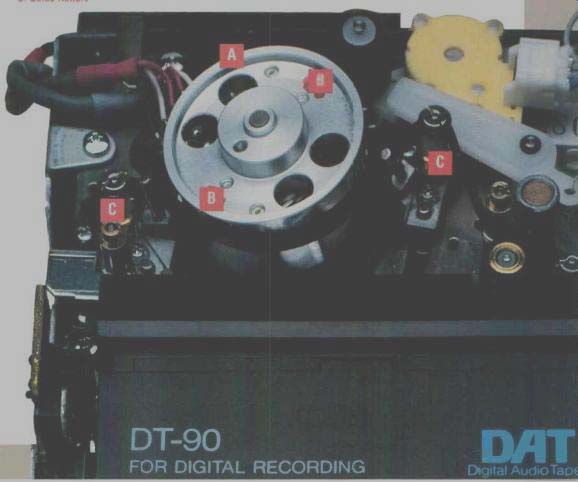
A. Rotary Drum B. Magnetic Heads C. Guide Rollers

--------- The DAT cassette shell features an erasure-prevention slider,
a full complement of recognition holes, and extraordinary physical protection
of the tape itself.
A MASTERPIECE OF MINIATURE ENGINEERING.
Perhaps the most impressive aspect of the DAT format is the cassette itself. A technological triumph in its own right, the DAT cassette can hold up to 10.8 billion bits of musical data. Yet it's 47% smaller than the standard audio cassette. The secret is that the metal particles that hold the magnetic signal have been reduced to sub-microscopic size.
The design of the DAT cassette protects these invisibly smell particles from the ravages of dust, dirt and fingerprints. When ejected from the deck, the tape shell snaps shut, sealing off not only the tape, but the reel hubs and guidepost holes as well. In this way, the cassette shell prepares DAT for the rigors of car and portable use.
------------
WHERE.
Where is the DAT format headed? Where will I be able to play my DAT cassettes? And where will I find prerecorded DAT? Many newcomers to the new format assume DAT is just for recording superlative tapes for playback at home. And while the new home DAT recorders will unquestionably meet such high expectations, these machines represent only the first chapter of the DAT story. Even at this early date, Sony can give some strong indications of what the future holds in store.
THE JOYS OF PLAYBACK
Many would-be DAT owners believe that the only tapes they'll play on their machines are the ones they've recorded themselves. So you may be surprised to learn that a growing band of audiophile record labels have discovered that DAT represents an excellent playback medium for their digital recordings. So such trend-setting jazz labels as GRP and DMP are releasing many of their best titles on DAT. Influential classical labels, such as Capriccio, Chandos and Sony's own Sony Classical' label are doing the same.
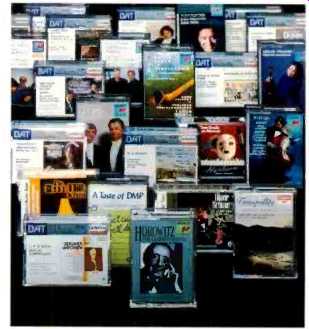
------------ Audiophile record labels have begun to introduce their best
digital recordings in the DAT format.
Sony is supporting these efforts in two important areas. We've created the world's first professional DAT duplication decks to produce prerecorded software. Next, we've installed a brigade of these duplicators in Sony's ultra-modern Digital Audio Disc Corporation plant in Terre Haute, Indiana. There, they form America's first DAT duplication facility, a resource not simply for our own record label, but for custom duplication available to anyone. Clearly, the DAT story encompasses not only hardware, but software, as well.
DAT. GOOD FOR YOUR SYSTEM.
As DAT has neared introduction on the U.S. consumer market, audiophiles have seen tantalizing glimpses of home high fidelity DAT recorders. With their awe-inspiring specifications, the first crop of DAT home decks have led music lovers to expect great things. These expectations will not be disappointed. With DAT, you'll experience sound quality on a par with today's best CD players. You'll have a choice of analog or digital inputs and outputs for the highest quality interface now and in the future. And you'll run the whole show by remote control.
As implemented by Sony in the DTC-700 and DTC75ES, home DAT brings with it the expertise we've earned throughout 15 years in digital recording.
You can hear it in hear it in our proprietary High Density Linear Converter' system. You can see it in our high-speed loading. And you can experience it in our ultra-stable 4 motor transport. Which means Sony decks not only define DAT, they also refine it.
DAT. RIGHT AT HOME AWAY FROM HOME.
But home decks certainly do not represent the full extent of DAT hardware. The fact is, DAT was designed at the outset for music on the go. For one thing, the flywheel effect of DAT's rotating head drum makes for amazingly stable tape playback during the shakes, jars, and jolts of mobile operation. Then there's the DAT cassette itself.
Its minuscule size was specifically chosen to facilitate the creation of car and portable players. And its sealed design helps protect the tape even when the environment is full of smoke, dust, dirt and grit.
All told, DAT is convincingly well-suited to the widest range of audio recording and playback applications.
THE DRIVING EXPERIENCE.
With DAT, not only can you enjoy your tapes at home, you can play them back in the car.
So you can drive while listening to the tapes you love, with the exacting standards of digital audio. Sony's new DTX-101 shows all the hallmarks that have made Sony the number one choice in car CD. This head unit looks for all the world like a conventional cassette receiver. Yet it contains a full function DAT player, an AM/FM tuner, and even control capability for a Sony DiscJockey® 10-disc changer. Sony fit all these abilities in a single DIN size chassis that will fit the dashboard of almost any car.
YOU CARRY IT AWAY--AND VICE VERSA.
Where is the perfect place to enjoy DAT? Wherever you happen to be. Portable DAT recorders make digital tape as versatile as analog tape. Of course, portable DAT is a natural for Sony and the TCD-D31DAT Walkman° recorder is just what you'd expect from Sony.
Quite simply, it's the world's smallest, full-function DAT recorder. Which means it's got microphone inputs and Sony's HDLC Analog-to-Digital Converter built right in. The TCD-D3 even gets two hours of battery life on a one-hour charge. Which typifies the thoughtful engineering of all Sony DAT machines.
YOU CAN'T HAVE GREAT TAPE RECORDING WITHOUT GREAT TAPE.
An indispensable part of the DAT format is the blank DAT cassette. And Sony wouldn't think of introducing the new hardware without the DT-60, 90 and 120 blank cassettes to go with it. At the heart of these DAT cassettes are Sony Crystal Art magnetic particles that you'd need an electron microscope to see but not to hear. Sony's UST coating places these particles across the tape surface with amazing uniformity. And Sony's proprietary HD & R binder system keeps them there. The sum total of which makes Sony DAT cassettes fully prepared for the rigors and the glories of Digital Audio Tape recording.
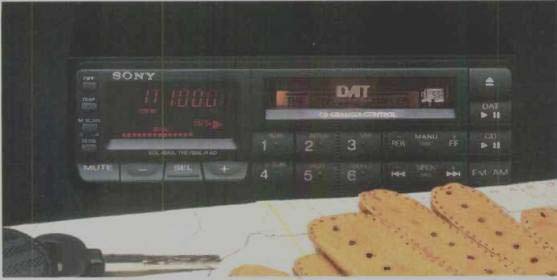
---------- Sony DTX-10 Car DAT Player/Tuner /Preamp
POISED FOR THE FUTURE.
There can be no doubt that DAT is much more than an interesting new piece of hardware. DAT represents the culmination of years of development in digital recording. DAT promises a wealth of exciting new opportunities in music recording and playback. And DAT embodies the next major step in the digitization of audio.
For more information on the format that brings tape recording into the digital age, call 1201-SONY-DAT during East Coast business hours. And speak to the people best qualified to answer your digital questions. Sony. The Leader in Digital Audio.

-------- Sony TCD-D3 DAT Walkman Recorder

------- Sony DTC-75ES DAT Recorder
----------------
HOME: SONY DTC-75ES DAT RECORDER
High Density Linear Converter" system
Four-motor tape transport with digital direct drive 2nd-generation DAT circuitry with digital
Large Scale Integrated circuits (LSI's)
Choice of 2and 4-hour recording and playback on a DT-120 tape Supplied Remote Commander® wireless remote control Optical, coaxial, and analog inputs and outputs 60-track programming Automatic Music Sensor'" track selection User programmable subcode functions
CAR: SONY DTX-10 DAT PLAYER/TUNER/PREAMP
Complete head unit with DAT playback, AM/FM tuner, and DiscJockey CD changer control in a single, standard DIN-sized chassis Compatible with Long Play mode 8x oversampling digital filter with dual 18-bit D/A converters 2nd generation proprietary digital LSI 3 motor transport Automatic power loading Automatic Music Sensor" track selection, Intro Scan, Repeat Play and Skip ID play Multi-function, switchable illumination display SSIR tuner with 18 FM and 6 AM preset stations Front and rear preamp outputs
PORTABLE: SONY TCD-D3 DAT WALKMAN® RECORDER
World's smallest and lightest DAT recorder with built-in Analog-to-Digital Converter Sony's HDLC A/D converter 8x oversampling with dual 18-bit D/A converters Digital and analog inputs and outputs Built-in mic inputs Compatible with Long Play mode Cue and Review at 25x normal speed Automatic Music Sensor" track selection Automatic and manual start ID's Supplied AC adaptor/charger Optional car bracket Optional wireless remote control Back-lit LCD display
TAPE: SONY DT-60, 90 AND 120 DAT BLANK CASSETTES
Crystal Art metal particles a mere 0.17 microns long achieve the highest information density of any tape format Sony's UST coating process for maxi-mum uniformity, minimum tape dropouts Proprietary HD & R (High Dispersion and Reliability) binder system for improved durability, play after play Professional-quality back coating for smooth, stable tape running High precision shell
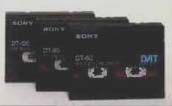
--------- Miracles of magnetic engineering, Sony DT-60, 90 and 120 blank
tapes are definitive expressions of tape recording technology.
© 1990 Sony Corporation of America. All rights reserved. Sony, Automatic Music Sensor, DiscJockey, High Density Linear Convener, Remote Commander, The Leader in Digital Audio, Sony Classical and Walkman are trademarks of Sony.
Features and specifications are subject to change without notice.
DAT products sold by manufacturer-authorized outlets incorporate the Serial Copy Management System, which will not prevent you from making a direct digital-to digital copy from a digital source, but from such copies will prevent a second direct digital-to-digital copy from being made.
Models DTX-10 and TCD-D3 available January, 1991.
SONY---THE LEADER IN DIGITAL AUDIO
Sony Corporation of America---National Operations Headquarters, Sony Drive, Park Ridge, New Jersey 07656, USA
(Audio magazine, Nov. 1990)
Also see:
Sony DTC-75ES DAT Recorder (Equip. Profile, Nov. 1990)
Sony DTC-2000ES DAT Recorder (Jan. 1995)
Harris XD-001 UH DAT Recorder (June 1989)
Sony TCD-D3 DAT Walkman Recorder (Jan. 1991)
Akai AD-93 (DAT) Digital Audio Tape Recorder (Jun. 1988)
DECIDING ON DAT: Witness of the Persecution (Mar. 1988)
Nakamichi 1000 DAT Recording System (Nov. 1989)
= = = =